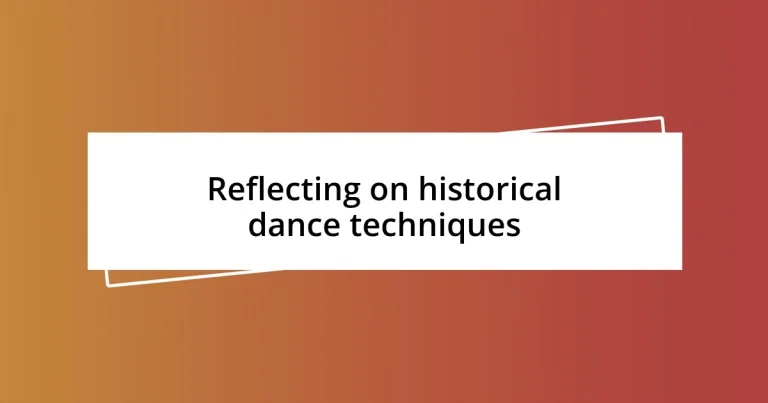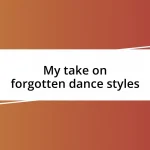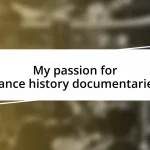Key takeaways:
- Historical dance techniques reflect cultural values and societal changes, acting as a narrative of human experiences and emotions throughout time.
- Key figures like Martha Graham, Isadora Duncan, and Alvin Ailey significantly influenced the evolution of dance, emphasizing emotional expression and cultural heritage.
- Cultural influences shape dance styles globally, with each form providing a unique connection to its history and community, making dance a powerful medium for storytelling and social commentary.
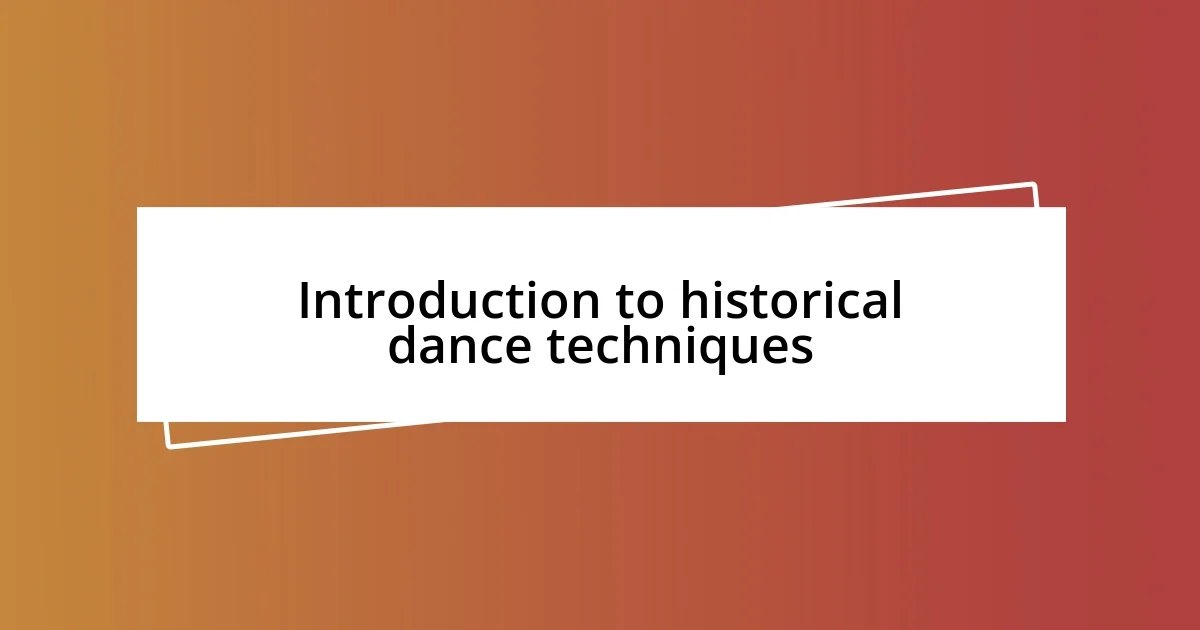
Introduction to historical dance techniques
Historical dance techniques are a fascinating window into the cultural practices of the past, telling stories through movement that transcend time. I remember when I first encountered these styles; I was captivated by how each step seemed to narrate a chapter of history. Have you ever watched a performance and felt transported to another era? That’s the magic of historical dance.
As I delved deeper into various dances—from the grace of the courtly minuet to the lively rhythms of folk dances—I found that each technique is a reflection of its society. The way people danced could reveal their social status, values, and even the everyday struggles they faced. Isn’t it intriguing to think that a simple dance step could hold so much meaning?
Exploring historical dance techniques has enriched my appreciation for the art form. Each dance is not just a series of movements; it’s an embodiment of a community’s spirit and creativity. So, when we dance, we don’t just move; we connect with those who came before us, sharing a collective experience that resonates deeply within.
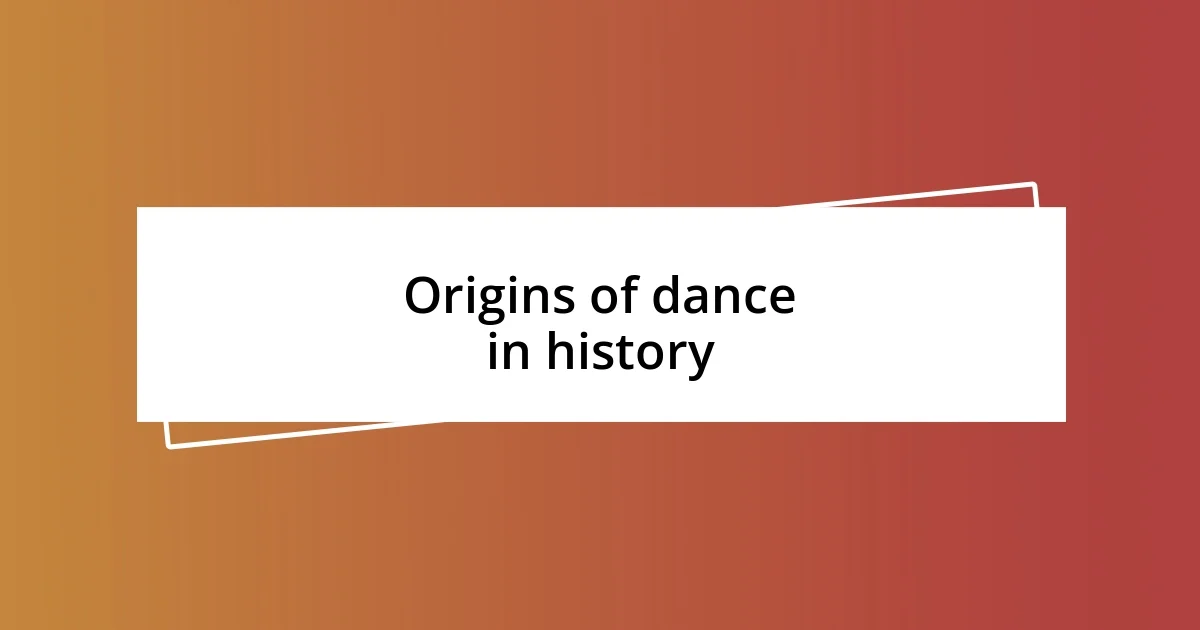
Origins of dance in history
The origins of dance stretch back to prehistoric times, often intertwined with rituals and celebrations. As a child, I remember being awestruck by documentaries showing ancient tribes dancing around fires, their movements echoing the sounds of drums and the calls of nature. Such performances weren’t just entertainment; they were essential expressions of spirituality and community bonding.
In ancient civilizations, like those of Egypt and Greece, dance played a pivotal role in religious ceremonies, storytelling, and social activities. I often reflect on the pictures of Egyptian hieroglyphics depicting dancers, and it strikes me how those same movements might have been celebrating gods or commemorating significant life events, creating a cultural continuity that echoes through time. These historic moments in dance don’t just tell us about the past but also about the universal human need to connect through movement.
The evolution of dance techniques signifies the shifts in societal values and norms throughout history. For instance, medieval court dances emphasized grace and etiquette, providing insight into the era’s social hierarchies. Sometimes I wish I could have joined a ballroom, experiencing firsthand the intricate choreography that reflected the elegance of noble life, allowing me to appreciate not just the art of dance but also its role in societal commentary.
| Time Period | Significance of Dance |
|---|---|
| Prehistoric Times | Rituals and community bonding |
| Ancient Civilizations | Religious ceremonies and storytelling |
| Medieval Era | Social etiquette and class distinctions |
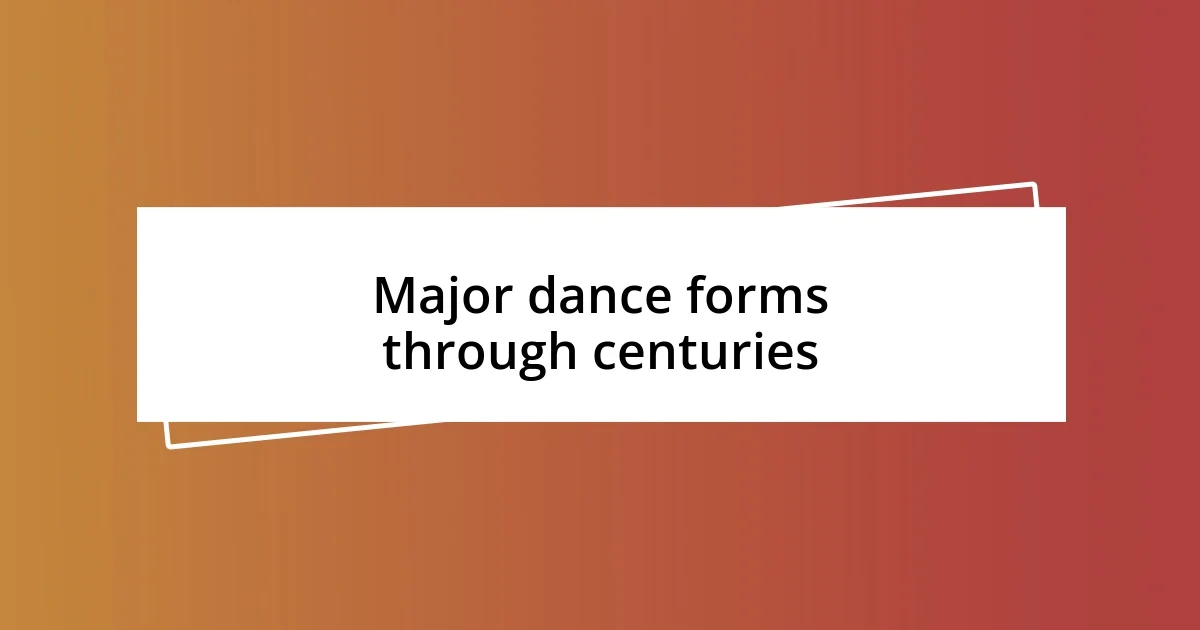
Major dance forms through centuries
Dance forms have evolved dramatically over the centuries, reflecting the cultural, social, and artistic values of their time. Growing up, I was drawn to the vibrant energy of the Charleston, with its captivating syncopated rhythms; it was a reminder of the Roaring Twenties, a period bursting with creativity and liberation. Each form, from ballet to tango, carries a legacy, telling stories that connect us to the past in ways that resonate powerfully today.
Here’s a brief look at some major dance forms across different eras:
- Ballet (15th-20th centuries): Originating in the Italian Renaissance courts, ballet emphasizes grace and precision, evolving into a theatrical form that combines dance with storytelling.
- Folk Dance (various time periods): Often without written records, these dances express the traditions and daily life of a community, embodying their joys and struggles.
- Jazz Dance (20th century): Emerging from African American communities, it represents a fusion of dance styles infused with improvisation and rhythmic freedom.
- Modern Dance (20th century): Breaking away from the constraints of ballet, modern dance explores emotional expression and body movement in innovative ways.
- Hip-Hop Dance (late 20th century): This energetic form, born from street culture, reflects social issues and personal experiences, providing a voice to the youth.
Each of these forms carries an emotional weight, transporting me to different times and places. I recall the first time I watched a performance of contemporary dance that made me feel vulnerable yet empowered. It reminded me that through movement, we can express complex emotions that words sometimes fail to capture. Isn’t it remarkable how each era of dance continues to shape our understanding of human expression?
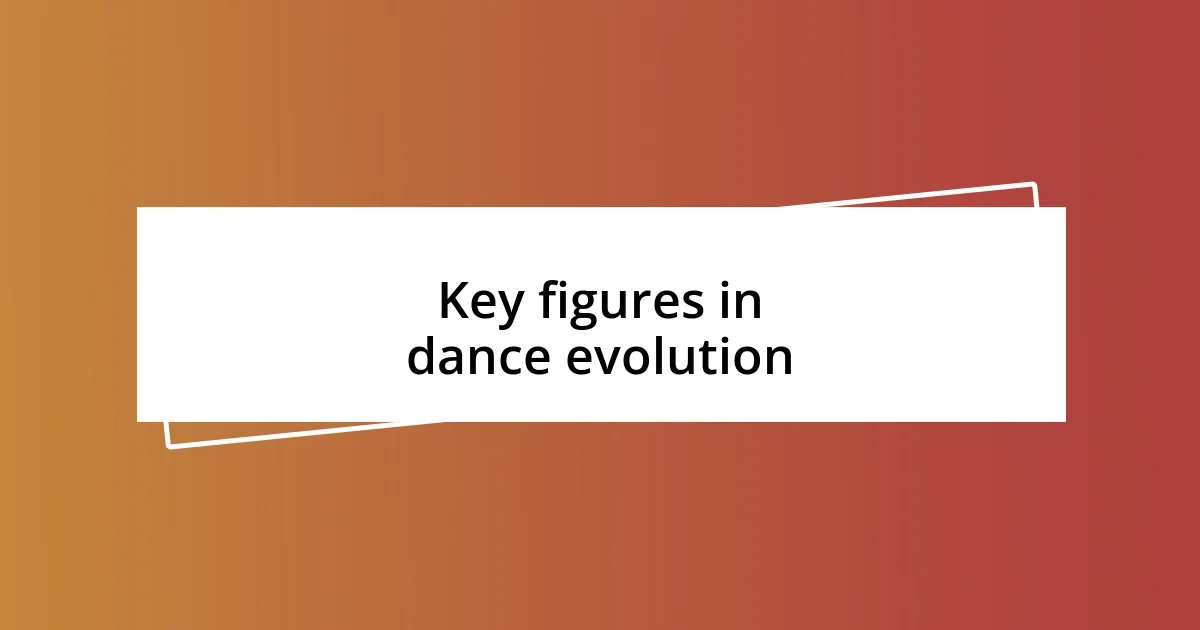
Key figures in dance evolution
Key figures in dance evolution
One of the giants in the dance world is Martha Graham. I remember watching one of her performances and being captivated by the raw emotion she channeled through her movements. Her style, rooted in expressing human experience, broke away from the traditional ballet forms and paved the way for modern dance. Isn’t it astounding how one person can redefine an art form and influence generations?
Another pivotal figure is Isadora Duncan, who I often think about when discussing the freedom of expression in dance. She embraced the natural movements of the body, drawing inspiration from ancient Greece, and often performed barefoot. The first time I tried to dance without shoes, I suddenly felt a connection to the earth beneath me—it was liberating! Her impact on contemporary dance is undeniable; she championed the idea that dance could convey personal feelings rather than just strict choreographed sequences.
Lastly, I can’t overlook the contributions of Alvin Ailey. His blend of African American cultural themes with diverse dance elements resonates deeply with me. When I attended a performance of “Revelations,” the celebration of heritage and struggle moved me to my core. It left me pondering how dance can be a powerful voice for social commentary. How can we ignore the ability of dance to reflect the complexities of human experience? Each of these figures has left a significant mark on dance, reminding me of the profound connection between movement and emotion.
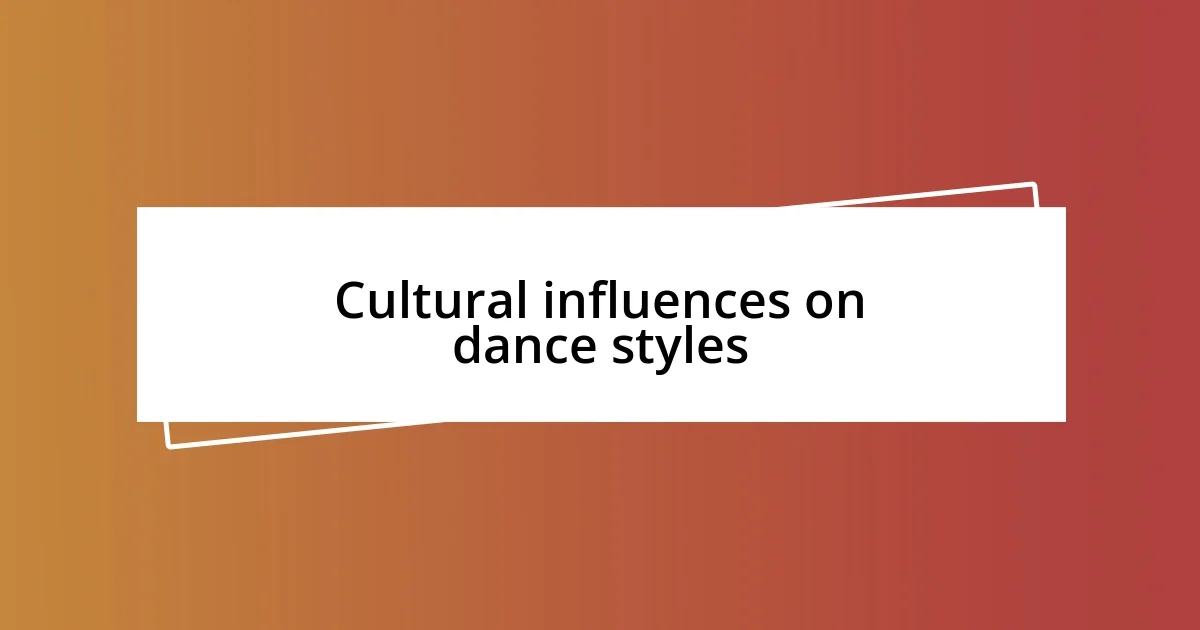
Cultural influences on dance styles
Cultural influences have a profound impact on the styles we see today, shaping dance techniques across the globe. For instance, when I think of the hula from Hawaii, I see how its movements beautifully reflect the rich history and mythology of the islands. The storytelling through dance not only honors tradition but also evokes a deep sense of connection to the land and people; it’s almost as if each wave of the hand brings a piece of culture to life.
In my experience, visiting a flamenco performance in Spain was transformative. The powerful expression conveyed through body language, footwork, and claps emanated the passion and struggles of the Spanish people. It’s as if every dancer embodies their ancestors, making the performance both a celebration and a remembrance. I often wonder how such styles can transmit emotions that resonate universally while remaining tied to specific cultural roots.
Moreover, consider the impact of migration on urban dance styles like breakdancing. When I first saw a group of dancers battling on a city street, I felt the raw energy and the blend of diverse influences; it’s fascinating how these styles evolve, amalgamating experiences from communities worldwide. How do these dance forms not only reflect individual expression but also narrate a collective cultural story that transcends borders? Each movement seems to tell tales that might otherwise remain unheard.
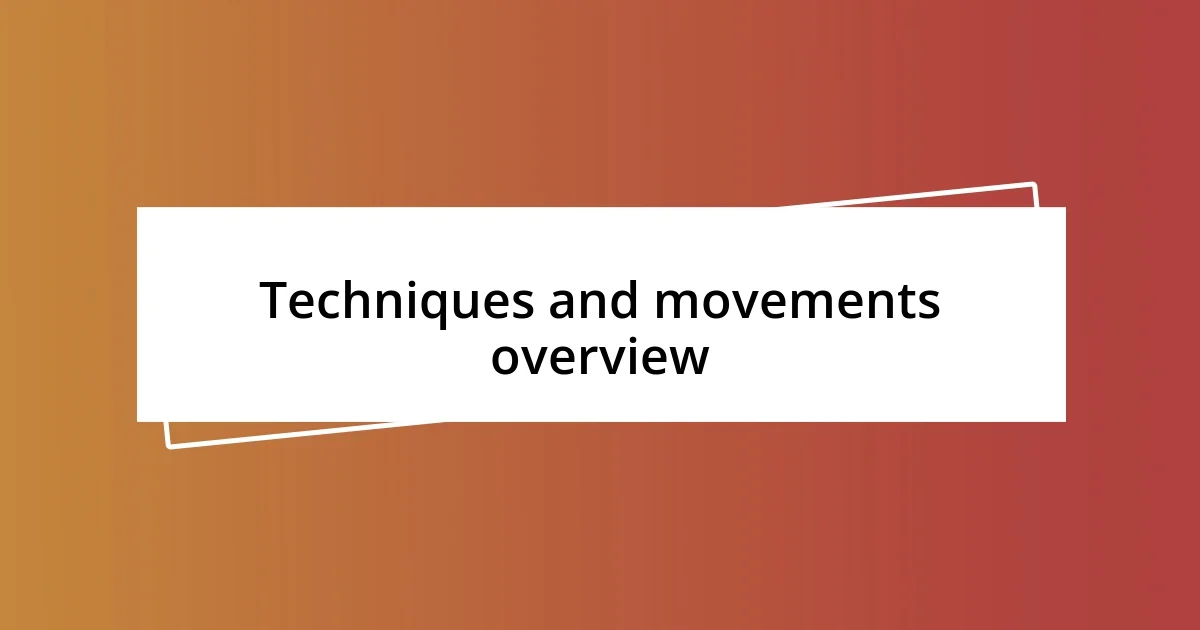
Techniques and movements overview
When exploring historical dance techniques, it’s crucial to recognize the foundational movements that characterize each style. For example, the gravity-defying leaps of ballet captivate me, especially when I remember my first ballet class. As I attempted a grand jeté, I felt both the joy of flight and the weight of technique; it’s a delicate balance that defines classical ballet. How can something so disciplined also feel so free? It’s this duality that draws me back to the beauty of ballet’s core techniques.
Similarly, I find the fluid arm movements in contemporary dance both mesmerizing and intricate. The first time I practiced a wave sequence, it felt like my body was merging with music, each ripple telling a story of its own. This style encourages individuality, allowing dancers to interpret movements that can feel both intimate and expansive. I often ask myself: how do these simple gestures hold such profound emotion, connecting the performer not just to the audience, but also to their own inner world?
Finally, let’s not overlook the grounding footwork seen in hip-hop. I remember the excitement of learning the popping and locking techniques—each movement seemed to pulse with a life of its own. It’s exhilarating to realize how these techniques emerged from urban environments, affecting not just the dancers but the entire culture. Can you feel the heartbeat of the streets in these movements? Each step is a testament to resilience and authenticity, a reminder that dance is not just an art form, but a living history intertwined with social commentary.
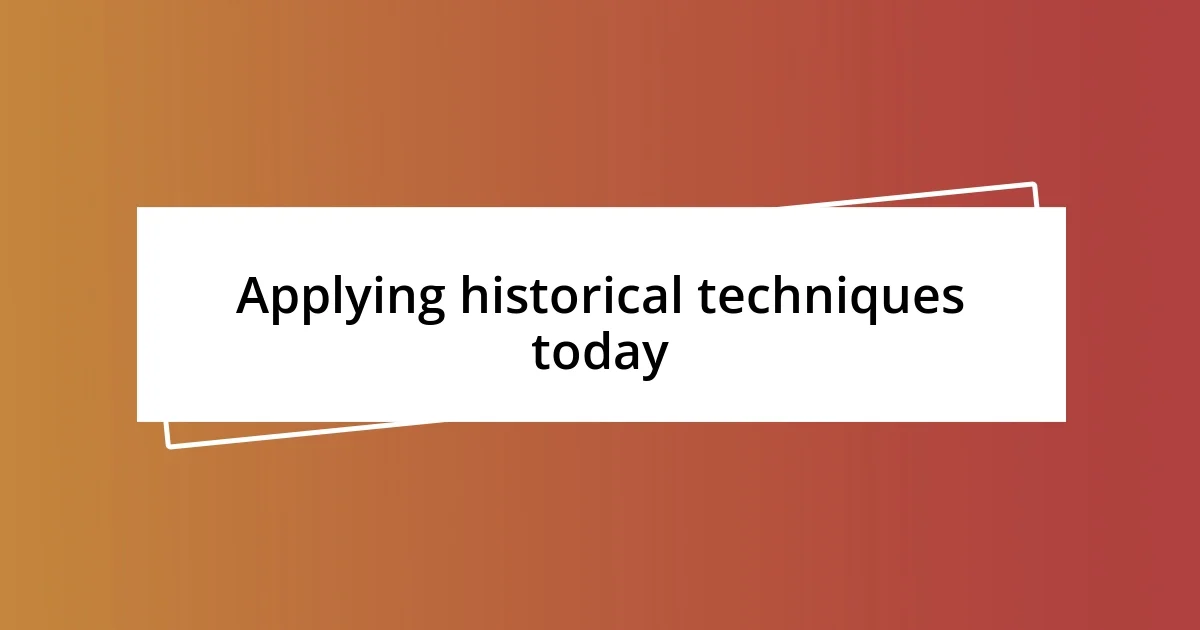
Applying historical techniques today
Incorporating historical dance techniques into modern practice can be an exciting journey. I remember my first workshop on traditional African dance; the rhythms and patterns were both exhilarating and humbling. Engaging with those age-old movements made me feel connected to something much larger than myself, as if I were stepping into a lineage that transcended time. How incredible is it to know that by dancing, we’re keeping history alive and relevant?
I often find myself pondering the relevance of these techniques in contemporary choreography. For instance, when I attend performances that blend hip-hop with elements of African or ballet styles, I am captivated by how dancers can reinterpret legacy steps, giving them a modern twist. It’s almost magical to witness an age-old movement presented in a completely new context, creating fresh dialogues about identity and culture. Have you ever experienced that moment when a familiar step suddenly sparks a new understanding?
As I dive deeper into the practice of historic dance techniques, I’m continually reminded of the emotional depth they carry. Recently, during a rehearsal that drew from Baroque dance, I felt an unexpected surge of grace and vulnerability, as if each movement allowed me to tell a personal story while echoing centuries of expression. This experience leads me to wonder: how can we each harness these historical styles to enrich our own artistic voices while honoring the past? The interplay of history and personal narrative is profoundly enriching, and it’s a path I’m excited to explore further.












